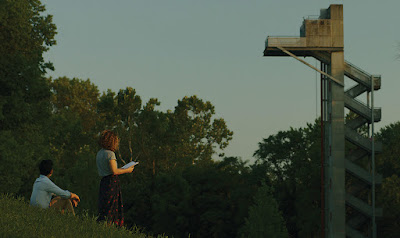FILM REVIEW: Architecture and angst star in Kogonada's artful Columbus
2017, US, directed by Kogonada, starring John Cho and Haley Lu Richardson.
Watch this if you liked: Before Sunset (2004), Paterson (2016)
Rating: A-
If one watched films just for the stories they told, Columbus would be a disappointment. Jin
(Cho in a rare dramatic performance) is compelled to stay in Columbus,
Indiana after his father falls ill. There, he meets Casey (Richardson bringing
depth to a somewhat clichéd role), a young woman obsessed with the city’s
unique architecture, but with family issues of her own. Together, they walk and
talk about art, building design and personal histories; their conversations
revealing the profound emotional connection that art can provide.
So far, so
Linklater whose Before trilogy set
the standard for this kind of gently paced conversation-led style, but without
the plot heavy clichés that Columbus
sometimes falls into. However, what makes this film so unique and watchable is
the artful way it’s composed. Directed by Kogonada in his feature debut (having
worked on video essays prior), the story’s simplicity is an asset, imploring
the audience to focus instead on the city’s buildings and the ways the
cinematic compositions echo them.
In an early
scene, Casey notes that the design of the library where she works is off-centre
yet symmetrical. The shot’s composition mirrors that, with her, a pair of trees
and the buildings all working to create a distinctly artistic shot which leads
us to a centralised focal point. Almost all of the other shots in the film use
the same technique, symmetry centred on a single middle point. This gives
Kogonada’s film a unique visual look which emphasises the prominent
architecture in the background bringing it to the foreground of the audience’s
focus.
Columbus is also concerned with the depth
of humanity’s connection to art. In the film’s most moving scene, Casey tells
Jin how she grew to love architecture, finding a beauty and simplicity that was
what she needed at one of her darkest moments. However, it’s another scene that
lingers because of what it refuses to explain. In one of their first
conversations, Casey takes Jin to one of her favourite buildings in the city. When
asked why she likes it, she gives him facts, but he presses her on it, asking
her to explain her emotional connection. Just as she’s about to do so, the film
switches shots. The camera is inside the building, behind glass and we cannot
hear her response. The sudden plunge into silence is effective and ambiguous.
The film seems to be asking us in this moment to think about our connection to
art and architecture.
Columbus’
emphasis on visual composition and gentle pacing over story is a unique choice
but here it pays off in spades. In its heavily structured images, it finds
beauty and light.

Comments
Post a Comment